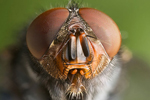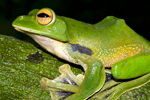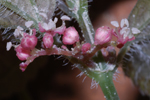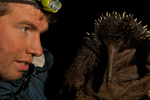Bigfoot genetics study published in journal created for bigfoot genetics study.
A new study purporting to uncover DNA evidence for Bigfoot has been published today in DeNovo Scientific Journal. While Bigfoot-enthusiasts have long argued that the cryptic monster is an unidentified ape species, the new study says their genetic evidence shows the Sasquatch is in fact a hybrid of modern human females mating with an unidentified primate species 13,000 years ago. The only problem: the journal in which the study is published—DeNovo Scientific Journal—appears to have been created recently with the sole purpose to publish this study.
According to the paper, a team of forensic scientists looked at 111 specimens of hair, blood, skin, and other tissues that were said to come from Bigfoot. The samples were gathered from 14 U.S. states and two provinces in Canada.
“We soon discovered that certain hair samples—which we would later identify as purported Sasquatch samples—had unique morphology distinguishing them from typical human and animal samples,” says lead author Melba Ketchum from DNA Diagnostics. “Those hair samples that could not be identified as known animal or human were subsequently screened using DNA testing, beginning with sequencing of mitochondrial DNA followed by sequencing nuclear DNA to determine where these individuals fit in the ‘tree of life.'”
 Statue of Bigfoot at roadside attraction in Washington state, U.S. Photo by: Plazak. |
According to Ketchum, the mitochondrial DNA (mtDNA) was clearly human, but the nuclear DNA (nuDNA) showed a mix of human and primate features. Mitochondrial DNA is only provided through one’s maternal line, while nuclear DNA is a mix of both maternal and paternal ancestry, leading Ketchum and her team to theorize that so-called Bigfoot is in fact the offspring of human females with as-yet-unidentified primates. The team have denied any chance of contamination within the samples.
“While the three Sasquatch nuclear genomes aligned well with one another and showed significant homology to human chromosome 11, the Sasquatch genomes were novel and fell well outside of known ancient hominin as well as ape sequences,” says Ketchum. “Because some of the mtDNA haplogroups found in our Sasquatch samples originated as late as 13,000 years ago, we are hypothesizing that the Sasquatch are human hybrids, the result of males of an unknown hominin species crossing with female Homo sapiens.”
Ketchum has stated that the new species be given the name, Homo sapiens cognatus, or “blood relative” to Homo sapiens.
But it’s likely that study will find little welcome in the scientific community, since it’s been published in a scientific journal that Ketchum’s team bought. In fact, Ketchum admits that the team acquired the rights to the journal before publication but says the paper was still “peer-reviewed,” which in scientific parlance means reviewed by an independent committee of experts before publication.
“Rather than spend another five years just trying to find a journal to publish and hoping that decent, open minded reviewers would be chosen, we acquired the rights to this journal and renamed it so we would not lose the passing peer reviews that are expected by the public and the scientific community,” Ketchum wrote on her website, which is currently off-line.
However Dr. Stuart Pimm, an ecologist at Duke University who runs the conservation non-profit Saving Species, said that believing in Bigfoot—i.e. a large hominin roaming North America undetected—denies the very basics of biology.
“Those who believe in Sasquatch, the Loch Ness Monster, and unicorns, have to overcome the inevitable requirements of sex,” he told mongabay.com. “Any remaining individual needs two parents, four grandparents, eight grandparents, and so on, back to a population large enough to have been viable to persist long enough to remain genetically distinct species. For large bodied species, such populations must occupy considerable geographical space, making the chance that they would remain ‘elusive’ vanishingly improbable. Those who imagine the hundreds of Sasquatch needed to persist scattered across 14 States are, in effect, assuming a mode of reproduction alien to this planet.”
Furthermore, Pimm points to indigenous people living in voluntary isolation in the much more remote Amazon rainforest, who despite small, wandering populations, still leave behind “abundant evidence of their presence.”
A few notable scientists, including Jane Goodall, have stated they thought it was possible that some unknown, large-bodied primate lived in North America, however most dismiss the idea citing lack of physical evidence.
Every year, scientists name thousands of species unknown to science. But most are insects, with the bulk of those beetles. While a few mammals are discovered every year, these are almost always rodents and bats. When a new primate is discovered it invariably comes from the Amazon, Africa’s rainforests, or Southeast Asia. There are no known primates in the U.S. or Canada.
CITATION: Ketchum MS, Wojtkiewicz PW, Watts AB, Spence DW, Holzenburg AK, Toler DG, Prychitko TM, Zhang F, Bollinger S, Shoulders R, Smith R. DeNovo. Novel North American Hominins, Next Generation Sequencing of Three Whole Genomes and Associated Studies. DeNovo Journal. 2013.
Related articles
Bloodsucking flies help scientists identify rare, hard-to-find mammals

(01/16/2013) Last year scientists released a study that is likely to revolutionize how conservationists track elusive species. Researchers extracted the recently sucked blood of terrestrial leeches in Vietnam’s remote Annamite Mountains and looked at the DNA of what they’d been feeding on: remarkably researchers were able to identify a number of endangered and rarely-seen mammals. In fact two of the species gleaned from these blood-meals had been discovered by scientists as late as the 1990s. In the past, trying to find rare and shy jungle animals required many man hours and a lot of funding. While the increasing use of remote camera traps has allowed scientists to expand their search, DNA sampling from leeches could be the next big step in simplifying (and cheapening) the quest for tracking the world’s mammals.
Geneticists discover distinct lion group in squalid conditions

(02/04/2013) They languished behind bars in squalid conditions, their very survival in jeopardy. Outside, an international team of advocates strove to bring worldwide attention to their plight. With modern genetics, the experts sought to prove what they had long believed: that these individuals were special. Like other cases of individuals waiting for rescue from a life of deprivation behind bars, the fate of those held captive might be dramatically altered with the application of genetic science to answer questions of debated identity. Now recent DNA analysis has made it official: this group is special and because of their scientifically confirmed distinctiveness they will soon enjoy greater freedom.
Photo: Subterranean ‘Moby Dick’ mermaid lizard discovered in Madagascar
(01/16/2013) An international team of scientists have described a bizarre new species of worm-like lizard that lives underground. Strangely, they named it the ‘Moby Dick’ mermaid skink.
New giant flying frog discovered near city of 9 million

(01/09/2013) Jodi Rowley is no stranger to discovering new amphibians—she’s helped describe over 10 in her short career thus far—but still she was shocked to discover a new species of flying frog less than 100 kilometers from a major, bustling Southeast Asian metropolis, Ho Chi Minh City. Unfortunately, the new frog, dubbed Helen’s tree frog (Rhacophorus helenae), may be on the verge of extinction, according to the description published in the Journal of Herpetology.

(01/08/2013) Last summer, after 55 dives, three scientists in a submarine off the coast of Japan encountered an animal people have mythologized and feared for thousands of years: the giant squid. According to the researchers with Japan’s National Science Museum they managed to capture the first footage ever (see below) of a giant squid in its natural habitat, although photos were also released in 2005 of a giant squid feeding.
Botanists discover cave-dwelling plant

(01/07/2013) The South China Karst region resembles a lost world with its stone forests and towering limestone formations that look like petrified skyscrapers. Standing at the edge of one of the region’s many vine-covered gorges, you could picture an apatosaurus lifting its head above the mist that blankets the gorge floor. Of course, that would be impossible, but what botanists recently found in the region was only slightly less surprising (to botanists). Near the back of a limestone cave, pink flowers bloomed on a newly discovered nettle that could survive on just a tiny fraction of the sunlight other plants receive. As Ian Malcolm in Jurassic Park said, “life will find a way.”
Scientists: bizarre mammal could still roam Australia

(01/03/2013) The continent of Australia is home to a wide variety of wonderfully weird mammals—kangaroos, wombats, and koalas among many others. But the re-discovery of a specimen over a hundred years old raises new hopes that Australia could harbor another wonderful mammal. Examining museum specimens collected in western Australia in 1901, contemporary mammalogist Kristofer Helgen discovered a western long-beaked echidna (Zaglossus bruijnii). The surprise: long-beaked echidnas were supposed to have gone extinct in Australia thousands of years ago.
New Guinea singing dog photographed in the wild for the first time
(12/03/2012) A rarely seen canine has been photographed in the wild, likely for the first time. Tom Hewitt, director of Adventure Alternative Borneo, photographed the New Guinea singing dog during a 12-day expedition up a remote mountain in Indonesian Papua. Very closely related to the Australian dingo, the New Guinea singing dog, so named for its unique vocalizations, has become hugely threatened by hybridization with domesticated dogs.
Whale only known from bones washes up on beach in New Zealand

(11/05/2012) In 2010, a whale mother and male calf were found dead on Opape Beach in New Zealand. Although clearly in the beaked whale family—the most mysterious marine mammal family—scientists thought the pair were relatively well-known Gray’s beaked whales (Mesoplodon grayi). That is until DNA findings told a shocking story: the mother and calf were actually spade-toothed beaked whales (Mesoplodon traversii), a species no one had ever seen before as anything more than a pile of bones.
Unidentified poodle moth takes Internet by storm

(08/29/2012) A white moth from Venezuela that bears a striking resemblance to a poodle has become an Internet sensation, after cryptozoologist Karl Shuker posted about the bizarre-looking species on his blog. Photographed in 2009 in Venezulea’s Canaima National Park in the Gran Sabana region by zoologist Arthur Anker from Kyrgyzstan, the white, cuddly-looking moth with massive black eyes has yet to be identified and could be a species still unknown to science.